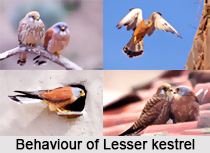 Lesser Kestrel is an Indian bird that bears a scientific name "Falco naumanni", is a small falcon bird.
Lesser Kestrel is an Indian bird that bears a scientific name "Falco naumanni", is a small falcon bird.
Breeding of Lesser Kestrel
Lesser Kestrel breeds from the Mediterranean across southern central Asia to China and Mongolia.
Migration of Lesser Kestrel
Lesser Kestrel is a summer migrant, wintering in Africa and Pakistan and sometimes even to India and Iraq. Lesser Kestrel is rare north of its breeding range, and declining in its European range. The scientific name of this bird commemorates the German naturalist Johann Andreas Naumann.
Structure of Lesser Kestrel
Lesser Kestrel is a small bird of prey, 27-33 cm in length with a 63-72 cm wingspan. It looks very much like the larger common kestrel but has proportionally shorter wings and tail. It shares a brown back and barred grey under parts with the larger species. The male has a grey head and tail like male common kestrels, but lacks the dark spotting on the back, the black malar stripe, and has grey patches in the wings. The female and young birds are slightly paler than their relative, but are so similar that call and structure are better guides than plumage. The call is a diagnostic harsh chay-chay-chay, unlike the common kestrel`s kee-kee-kee. Neither sex has dark talons as is usual in falcons; those of this species are a peculiar whitish-horn colour. This, however, is only conspicuous when birds are seen at very close range, e.g. in captivity.
Lesser Kestrel is, as the name implies, a smaller and more delicate bird than the common kestrel, and it is entirely sympatric in its breeding range with it; they compete to a limited extent. Thus, the possibility that there is some form of adaptive advantage to the similar coloration deserves study. Considering that the lesser kestrel would in fact have an advantage if some would-be predators confused it with the larger species and consequently avoided it, it might be a case of Mullerian mimicry.
Prey of Lesser Kestrel
Lesser Kestrel eats insects, but also small birds, reptiles and rodents, which are often taken on the ground. It nests colonially on buildings, cliffs, or in tree holes, laying up to 3-6 eggs. No nest structure is built, which is typical for falcons. On their wintering grounds in West Africa, lesser kestrels favour a "latitude belt" through Senegal where locusts and grasshoppers are plentiful. It is widespread and plentiful on a global scale, and the IUCN have classed it as Least Concern. Apart from possible habitat destruction, it appears that indiscriminate use of pesticides has a strong effect on this species due to its insectivorous habits.











